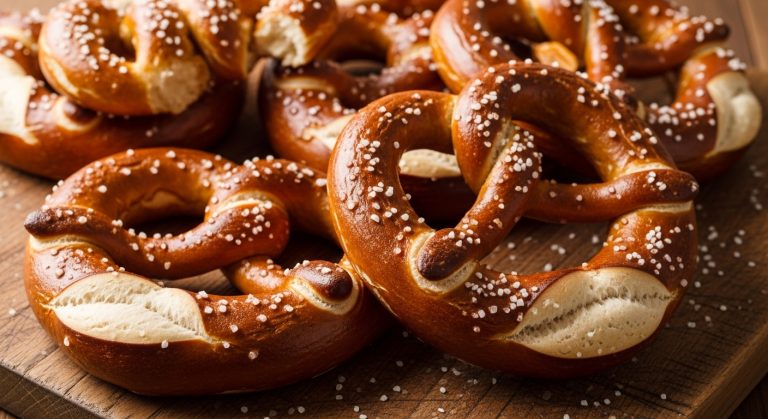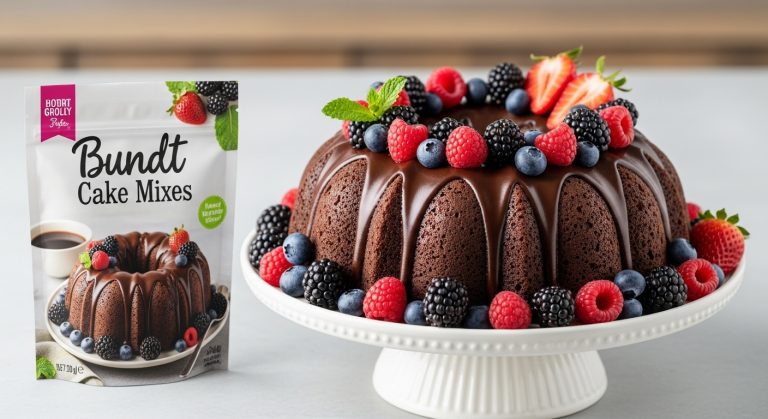Silky Soft Cake Flour: Secrets to Perfectly Tender Cakes
You’ll find silky soft cake flour finely milled to a powdery texture with low protein—around 6–8%—which limits gluten formation, yielding tender, moist cakes with delicate crumbs.
Bleaching enhances its whiteness and boosts water absorption, improving batter aeration and crumb softness.
Its refined starch and controlled protein balance optimize leavening for higher volume and finer texture than all-purpose flour.
For techniques on handling, measuring, and selecting brands that maximize these qualities, keep exploring deeper insights.
- Does not contain baking powder or salt
- Ideal flour for all of the special baking needs
- Made from the finest American soft winter wheat
Key Takeaways
- Silky soft cake flour contains 6–9% protein, producing a tender crumb with weak gluten for fine, delicate cake textures.
- It is finely milled using roller milling and purifiers to ensure uniform particle size and whiteness.
- Bleaching improves its whiteness, lowers pH, and enhances water absorption for softer, larger cake crumbs.
- Its fine texture optimizes leavening agent distribution, promoting light, airy cakes with higher volume and moistness.
- Popular brands like Swans Down and Softasilk are bleached and finely milled, ideal for spongy, tender cakes.
Comparing Silky Soft Cake Flour to Other Flours
| Flour Type | Protein Content (%) | Texture in Bakes | Best For | Bleached/Unbleached | Key Benefit | Possible Drawback |
|---|---|---|---|---|---|---|
| Silky Soft Cake Flour | 6–8 | Tender, fine crumb | Sponge cakes, chiffon, cupcakes | Often bleached | Produces light, airy cakes with high volume | Not ideal for dense breads |
| All-Purpose Flour | 10–12 | Medium crumb, denser texture | Cookies, muffins, general baking | Both | Versatile for many recipes | Can make cakes tougher |
| Pastry Flour | 8–9 | Soft, slightly denser than cake flour | Pies, tart shells, muffins | Usually unbleached | Good balance of tenderness & structure | Less volume than cake flour |
| Bread Flour | 12–14 | Chewy, structured crumb | Yeast breads, pizza dough | Usually unbleached | Strong gluten for rise & chew | Makes cakes dense & heavy |
Protein Content in Cake Flour
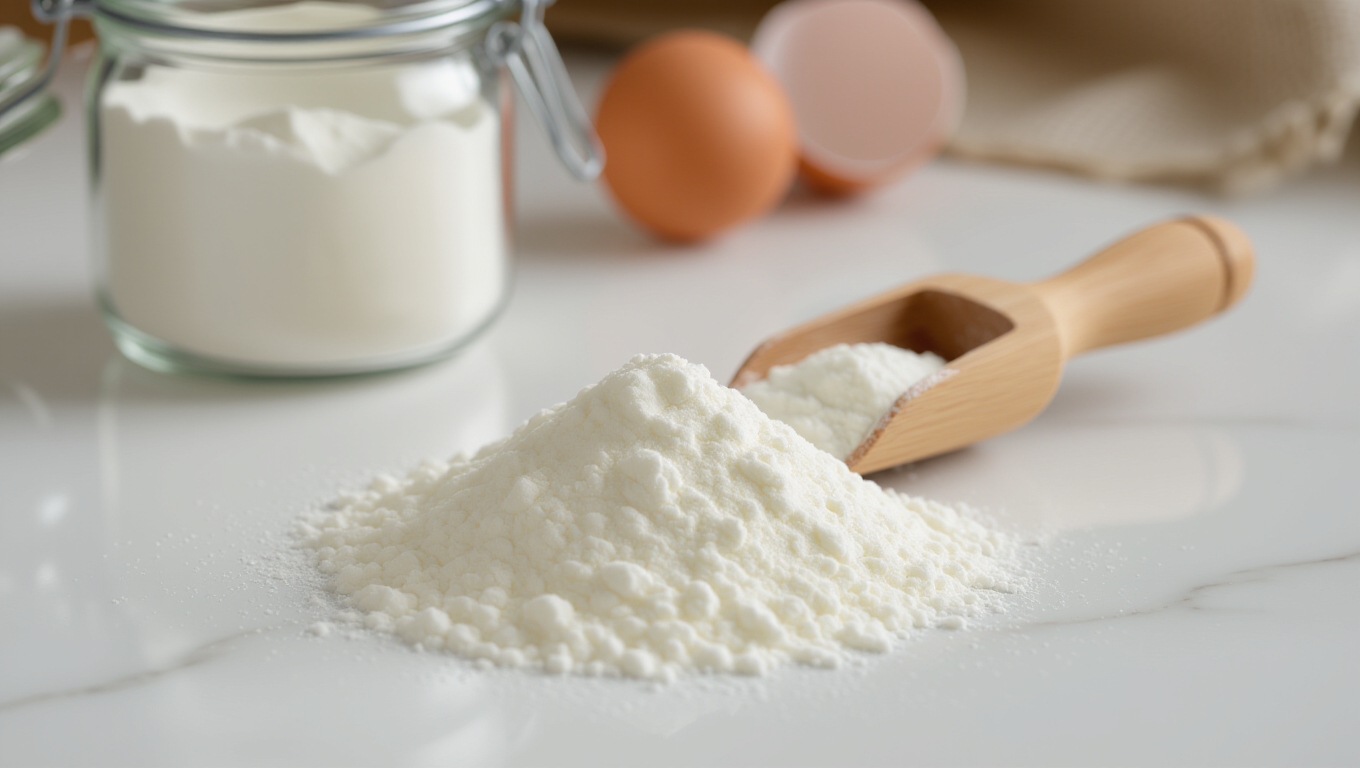
Although cake flour varies by brand and type, its defining characteristic lies in its low protein content, typically ranging from 6% to 9.4%. This protein level is markedly lower than in all-purpose flour (10–12%) and pastry flour (8–9%).
Brands like Pillsbury Softasilk have about 6.9% protein, while King Arthur ranges up to 9.4%. Protein in flour mainly consists of glutenin and gliadin, which form gluten when hydrated. Because cake flour’s protein is minimal, it produces weak gluten networks, resulting in tender, soft crumb structures ideal for delicate cakes.
Using a sharp tool to handle delicate doughs ensures precision in baking techniques. Measuring protein content, expressed as grams per 100 grams of flour, is essential for bakers to select appropriate flours.
This lower protein content is key to achieving the fine, silky texture that defines cakes made with cake flour. In baking, knowing the typical protein ranges for flour types helps ensure the right texture and structure for each recipe.
- We’ve reformulated our unbleached cake flour to be even better than before. Improved for better…
- Milled from the finest American wheat, our flour contains no bleach, no bromate and no artificial…
- King Arthur Cake Flour Unbleached and Unenriched is Non-GMO Project Verified and has 10% protein…
The Milling Process and Texture of Cake Flour
You rely on fine milling techniques to achieve the delicate particle size vital for cake flour’s silky texture. By controlling roller gaps and grinding passes, you reduce coarse fragments that cause clumping and uneven hydration.
This precise milling guarantees smooth flour that blends uniformly, promoting consistent batter aeration and tender crumb formation. The use of reduction rolls in the milling stage allows for progressive particle size reduction, which is crucial in achieving the desired flour texture and performance.
Similarly, controlling protein content in flour is key to obtaining the ideal texture in baked goods, as seen with bread flour in focaccia preparation.
Fine Milling Techniques
When producing cake flour, fine milling techniques play a critical role in achieving its signature silky texture and baking performance. You rely on multiple passes through reduction rolls, which progressively refine endosperm particles to an ultra-fine size.
This precision guarantees consistent particle distribution essential for delicate crumb structure. Purifiers remove residual bran from middlings, maintaining the flour’s purity and whiteness. You also control temperature throughout milling to prevent heat buildup, preserving flour softness and shelf life.
Maintaining low heat during milling is important because excessive heat can degrade nutrients and affect flour quality. The impressive shelf life of quality baking ingredients like flour contributes to consistent results in baking applications.
Roller milling outperforms stone milling here by producing finer, more uniform flour with lower bran content, optimizing gluten development for tender cakes. Proper grain tempering before milling eases bran separation and enhances particle size control. Together, these techniques allow you to craft cake flour with the precise physical and functional properties indispensable for superior baking outcomes.
Texture and Clumping
Fine milling not only refines cake flour’s particle size but directly influences its texture and tendency to clump. By removing bran and germ, the process isolates the starchy endosperm, yielding a soft, delicate flour with fine, uniform particles. Proper storage techniques are important to preserve this texture and prevent spoilage, much like how sourdough starters require careful maintenance to avoid mold and bacterial issues.
Automated tempering adds moisture, ensuring pliable kernels and consistent milling, which prevents excessive clumping. This fine particle size increases surface area, allowing quicker, even absorption of liquids and fats, enhancing batter homogeneity. Cake flour typically contains about 6-7% protein, which is lower than plain flour, contributing to its tender crumb.
Bleaching further softens the flour and modifies starch properties, reducing lump formation. Despite this, improper storage or packing can cause clumping, so you should always sift cake flour before use.
The combination of low protein content, precise milling, and conditioning optimizes flour texture, promoting a tender crumb and consistent cake volume.
How Bleaching Affects Cake Flour Quality?
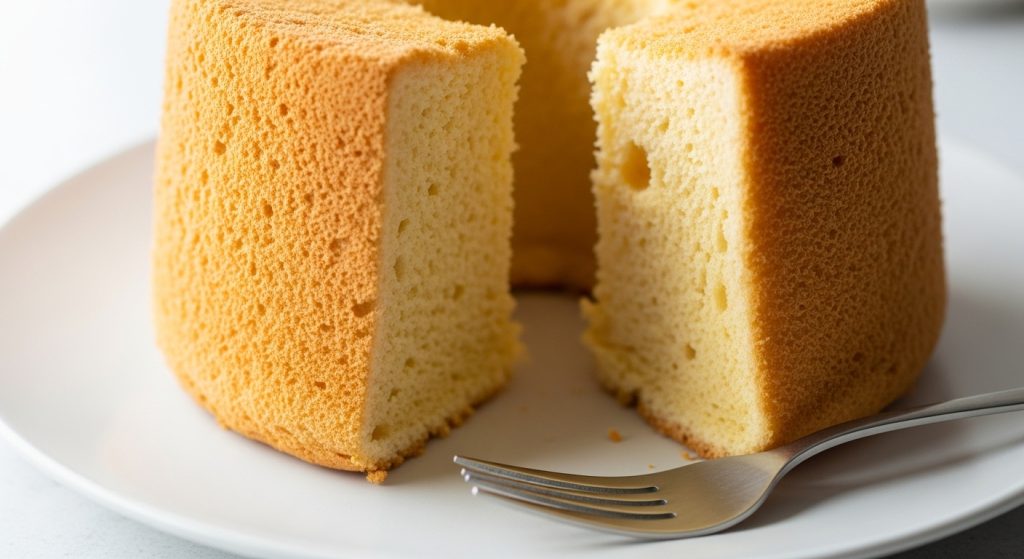
Although bleaching primarily aims to improve the visual appeal of cake flour by removing natural pigments, it also induces significant chemical changes that directly influence baking performance. Chlorine gas, the chief bleaching agent, lowers flour pH to about 4.4–4.8 and oxidizes starch granules, accelerating gelatinization during baking.
This natural aging process is replaced by chemical treatment in bleached flour, which speeds up whitening. This partial depolymerization enhances flour’s absorbency of sugar, shortening, and water, which are vital for high-ratio cakes.
As a result, bleached cake flour sets faster, boosting leavening retention and producing a larger, softer crumb with improved structure. Accurate ingredient measurement using digital baking scales is essential to fully realize these benefits in delicate cake recipes.
However, bleaching can impart subtle off-flavors due to chlorine or benzoyl peroxide residues, which some sensitive palates detect. Despite these sensory effects, bleaching remains a controlled process that balances functional improvements with safety regulations, ensuring consistent, high-quality cake flour suitable for delicate baked goods.
Baking Benefits of Using Cake Flour
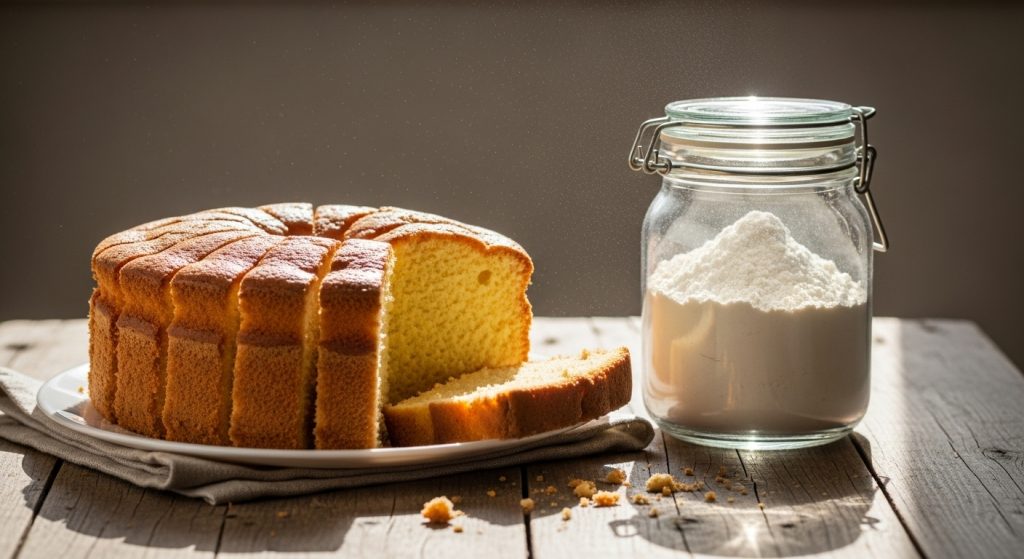
When you use cake flour, its low protein content minimizes gluten formation, giving your cakes a tender, delicate crumb. The fine milling and balanced starch promote even aeration, helping your batter rise higher without collapsing. These properties combine to deliver a soft texture with enhanced volume, ideal for light, airy cakes.
Additionally, cake flour is typically bleached, which weakens proteins and improves water absorption, resulting in thicker batters and higher cake height bleaching process. Proper storage conditions are essential to maintain flour quality and prevent mold contamination that could affect the final baked goods.
Tender Crumb Texture
Because cake flour contains a lower protein content and undergoes fine milling and bleaching, it minimizes gluten development, resulting in a tender crumb texture that feels silky and delicate.
This reduced gluten formation limits toughness, while fine milling ensures even fat and moisture absorption, producing a smooth, cohesive crumb. This is similar to how gluten development is carefully managed in sourdough bread to control texture and structure.
Bleaching modifies proteins to enhance moisture retention and softness, leading to a crumb that breaks apart easily and melts on your palate. Additionally, the fine texture of cake flour optimizes the effectiveness of leavening agents, allowing gas bubbles to expand and create a light, airy cake.
Enhanced Cake Volume
Given cake flour’s lower protein content of 6-8%, it limits gluten formation, allowing your batter to expand more freely and trap air efficiently. The weaker gluten network promotes greater volume by supporting air retention throughout mixing and baking.
Additionally, cake flour’s higher starch content improves moisture absorption and batter viscosity, stabilizing air bubbles and enhancing rise. Its fine, silky texture facilitates uniform leavening agent distribution and thorough aeration, further increasing cake height. This is why recipes calling for cake flour can often be successfully made with all purpose flour using the ratio of 3/4 cup plus 2 tbsp per cup, ensuring proper substitution ratios.
Unlike all-purpose flour, which forms a stronger gluten matrix leading to denser cakes, cake flour produces lighter, taller results with a finer crumb. To maximize volume, you’ll need to adjust liquid ratios slightly, ensuring ideal hydration.
Comparing Cake Flour With Other Types of Flour
Although cake flour shares the basic function of providing structure in baking, it differs markedly from all-purpose and bread flours in protein content, milling, and baking performance. Cake flour contains 7-9% protein, limiting gluten formation and ensuring a tender, delicate crumb. This lower protein content also affects the gluten development during mixing, making cake flour ideal for soft, airy textures.
In contrast, all-purpose flour’s 10-12% protein yields a coarser texture, while bread flour’s 12-14% protein creates strong gluten networks unsuitable for fine cakes. The protein percentage indicates gluten-forming potential; higher protein means stronger flour.
Cake flour’s finely milled, often bleached particles produce a lighter, softer batter, enhancing aeration and cake volume.
Using all-purpose flour instead results in denser, chewier baked goods. If you substitute, mix cornstarch with all-purpose flour to mimic cake flour’s lower protein and finer texture.
Popular Cake Flour Brands and Their Features
When selecting cake flour, you’ll find that brand choice markedly affects texture, flavor, and crumb structure due to variations in protein content, bleaching, and milling processes.
Here are three popular options to contemplate:
Consider these three popular cake flour options to achieve your perfect cake texture and flavor.
- Swans Down offers bleached flour with 6-7% protein, producing soft, spongy cakes with a pale crumb—ideal for delicate textures but less suited for heavy frostings. Professional bakers often pair such flours with precision decorating tools to create visually stunning cakes.
- King Arthur provides an unbleached blend around 7-8% protein, yielding a slightly darker, shorter crumb with a hint of cornbread texture, favored for scratch baking consistency. It is known for being more versatile and forgiving, suitable for a wide range of baked goods including pies and structured cakes due to its higher protein content.
- Softasilk features bleached, finely milled flour that creates spongy, moist cakes with a subtle flavor, often preferred by professionals for classic yellow cakes.
Tips for Proper Handling and Measuring of Cake Flour
To achieve the delicate texture that cake flour promises, you must handle and measure it with care and accuracy. First, store cake flour in a cool, dry place, sealed tightly to prevent moisture and contamination. Proper storage also helps maintain the microbial health vital for fermentation in baked goods.
For long-term freshness, refrigerate or freeze it, especially in humid environments. When measuring, fluff the flour to aerate it, then spoon it lightly into your measuring cup without packing. Level off with a flat edge for precision. Using a scale can greatly improve accuracy because flour weight matters.
For best results, weigh the flour on a kitchen scale, as volume can vary. Handle cake flour gently to preserve its fine texture, and avoid overmixing batters to prevent gluten overdevelopment.
Clean all utensils and surfaces after use to prevent cross-contamination, and never consume raw flour or batter to guarantee safety.
Best Recipes to Showcase Cake Flour’s Unique Properties
Because cake flour’s lower protein and finer granules particularly affect texture, selecting the right recipes allows you to fully showcase its unique properties. When you use cake flour, you reveal tender, moist crumbs and delicate structures impossible with higher protein flours.
Here are three ideal recipe categories:
- Layer and Sheet Cakes: Cake flour reduces gluten, ensuring pliable, tender layers that stack smoothly and absorb frostings evenly without crumbling.
- Angel Food and Chiffon Cakes: Its fine granules trap air efficiently, producing light, airy cakes with a spongy yet resilient crumb. Using a cake flour substitute made of all-purpose flour and cornstarch can mimic these effects when cake flour is unavailable.
- Butter Cakes and Cupcakes: Cake flour maintains structure while delivering a soft mouthfeel, enhancing moistness and lift, perfect for rich, buttery flavors or delicate cupcakes.
Frequently Asked Questions
Can Cake Flour Be Stored Long-Term Without Losing Quality?
You can store cake flour long-term without losing quality if you control oxygen, moisture, and temperature.
Repackage it in airtight containers or food-grade mylar bags with oxygen absorbers to prevent oxidation and pests.
Keep it in a cool, dry, dark place, or freeze it to extend shelf life up to two years.
Avoid temperature fluctuations and exposure to light to maintain its texture and flavor, ensuring your baked goods stay fresh and consistent.
Is Cake Flour Gluten-Free or Suitable for Gluten-Sensitive Diets?
You might hope cake flour dances lightly around gluten concerns, but it still carries wheat’s natural proteins. With a modest gluten presence, it crafts tender crumbs yet isn’t suitable for gluten-sensitive diets.
If you manage gluten intolerance, you’d better opt for dedicated gluten-free flours like almond or oat, which avoid wheat entirely. Cake flour’s low gluten content means softness, not gluten absence, so it’s not safe for celiac or gluten-sensitive individuals.
How Does Cake Flour Affect Frosting or Icing Texture?
When you use cake flour in frosting, it creates a smooth, silky texture by limiting gluten formation due to its low protein content. This yields a pudding-like paste that stabilizes the buttercream, making it soft yet spreadable.
Your frosting will have a refined, airy density without heaviness or graininess, improving pipeability and shape retention. Additionally, the mild flavor enhances sweetness balance without overpowering other ingredients, ensuring a clean, delicate finish.
Can Cake Flour Be Used for Non-Baked Desserts Like Mousse?
Sure, you could toss cake flour into a mousse, but why risk gritty texture and raw taste? Cake flour’s low protein and delicate starches need heat to gelatinize, which mousse recipes avoid.
Instead, you’re better off using gelatin or agar-agar for smooth, stable aeration. Flour in mousse not only compromises safety but also ruins that light, airy mouthfeel you’re aiming for.
Does Cake Flour Contain Any Allergens Besides Wheat?
Cake flour primarily contains wheat gluten, the main allergen you’ll encounter. It typically doesn’t include other allergenic ingredients like eggs, milk, or soy. However, some commercial brands might carry trace amounts of these allergens due to cross-contamination during manufacturing.
You should always check the packaging for “may contain” warnings to be safe. Homemade cake flour substitutes usually only pose a wheat allergen risk, as they contain wheat flour and cornstarch, which isn’t allergenic.
Make Every Slice a Soft, Fluffy Masterpiece
By choosing silky soft cake flour, you’re giving your baked goods the perfect foundation—like a painter selecting the finest brush. Its low protein content and delicate milling create tender crumbs and a light, airy texture.
Remember, proper handling and measuring amplify its benefits, ensuring consistent results. Whether you’re crafting a classic sponge or an intricate layer cake, cake flour transforms your baking into a precise science of softness and fluffiness.
- Milled from 100% US Wheat
- Never bleached; Never Bromated; America’s finest flour since 1790
- King Arthur Flour is a 100% Employee-Owned Company
Last update on 2026-01-09 / Affiliate links / Images from Amazon Product Advertising API







